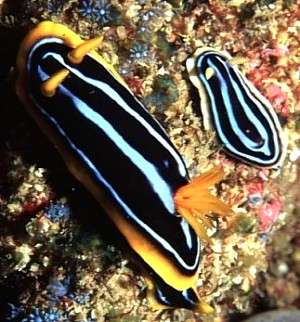Colour variation within a species
This page is for messages concerned with the question of colour variation within a species. There are many different types of intraspecific (within a species) colour variation. For example, in some species the juveniles seem to be much more lightly pigmented than the adults. In other species, pigments from their food are reused to create a camouflage colouration, so individuals within the same species can differ in colour depending on the colour of their food. Apart from these special examples, all individuals within a species show some colour variation, just as we do. However we need to know what the limits of this variation are so that we can, where possible, identify species from their colour pattern.
All aspects of this variation will be discussed below.
Authorship detailsRudman, W.B., 2000 (May 8) Colour variation within a species. [In] Sea Slug Forum. Australian Museum, Sydney. Available from http://www.seaslugforum.net/find/colourvar
Related messages
Colour variation
May 9, 2000
From: Nerida Wilson

Hi Bill,
This picture of an adult and juvenile Chromodoris kuiteri, seems to show how the intensity of some colours changes with age. I think Valda Fraser mentioned this in reference to Chromodoris cf geminus. Is this happening
a) only in some groups eg. Chromodoris?
b) only with some colours eg. orange?
Does anyone else have similiar examples that may shed some more light on the matter?
Thanks
Nerida.
nwilson@zen.uq.edu.au
Wilson, N., 2000 (May 9) Colour variation. [Message in] Sea Slug Forum. Australian Museum, Sydney. Available from http://www.seaslugforum.net/find/2228Dear Nerida,
I'm sorry I didn't post this question earlier. I put it to one side to look out some photos but haven't found them so let's see what others have to say.
Basically I don't think age usually has much to do with colour intensity once animals have passed quite a small stage. Hatchlings, and recently settled young certainly have very pale colouration but that is usually through lack of pigment rather than presence of very pale pigment. I think in your example, the smaller animal will have the pale orange colour throughout its life. The black pigment is certainly as intense as in the larger animal. That is not to say that in some species such as Chromodoris cf geminus the colour does become more intense as they grow. I just don't think there is a standard rule.
I will try and find some juvenile examples.
In the meantime has anyone else any ideas or examples?
Best wishes,
Bill Rudman.
